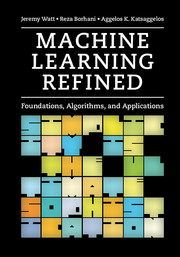Part I - Fundamental tools and concepts
Summary
In the three chapters that follow we describe in significant detail the basic concepts of machine learning introduced in Chapter 1, beginning with an introduction to several fundamental tools of numerical optimization in Chapter 2. This includes a thorough description of calculus-defined optimality, as well as the widely used gradient descent and Newton's method algorithms. Discussing these essential tools first will enable us to immediately and effectively deal with all of the formal learning problems we will see throughout the entirety of the text. Chapters 3 and 4 then introduce linear regression and classification respectively, the two predictive learning problems which form the bedrock of modern machine learning. We motivate both problems naturally, letting illustrations and geometric intuition guide our formal derivations, and in each case describe (through a variety of examples) how knowledge is used to forge effective features.
- Type
- Chapter
- Information
- Machine Learning RefinedFoundations, Algorithms, and Applications, pp. 19 - 20Publisher: Cambridge University PressPrint publication year: 2016



